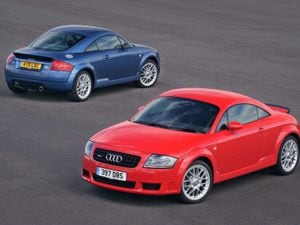The history of the Audi TT
As Audi’s iconic sports model bows out of production, we look back at its history.

There are some cars that offer an incredibly recognisable shape and silhouette, and one of those is the Audi TT.
Across its three generations, all versions have shared similar styling, and have built up a loyal following since the TT was first introduced in 1998. It’s become one of the most iconic pieces of car design in modern history.
But the TT will soon be no more, as Audi looks to focus more on electrification, which this petrol-powered sports car just can’t be a part of. Ahead of the model being discontinued later in 2023, we take a look back at the TT’s history.
1995 – The concept begins

The TT story began fully in 1995 when Audi presented a concept version of its sports car at the Frankfurt Motor Show. There was a noticeable gap in the German firm’s line-up for a more affordable sporting model, and the TT aimed to fit the bill, with its cool shape and fun drive.
The TT gets its name from the famous Isle of Man Tourist Trophy (TT) bike racing.
1998 – Concept becomes reality

Concept cars are often far-fetched models that only show a tiny part of what may end up making production.
Not the TT, however, as when Audi presented the production model three years later, it shared sharp similarities with the original concept car, with its cool shape and design details remaining intact. The Coupe model was presented in 1998 with a drop-top Roadster version arriving a year later.
The TT story didn’t get off to a perfect start, however, as the model was involved in several high-profile crashes, caused by stability issues at particularly fast speeds. It lead Audi to issue a full recall that provided a remedy in the form of a rear spoiler and electronic stability program. Interestingly, it’s cars that escaped the recall that are now the most valuable.
2003 – V6 engine joins the range

The TT had been available for several years with a choice of 1.8-litre turbocharged petrol engines, as well as Audi’s famed quattro all-wheel-drive system.
But in 2003 the TT gained more character in the form of a 3.2-litre petrol V6 engine, taking the power up to 247bhp. This engine came with quattro as standard.
2005 – Quattro Sport marks the end of the Mk1

Marking the end of the first-generation TT was the Quattro Sport special edition. Limited to 800 units in the UK, it got a power increase from its 1.8-litre petrol engine to 237bhp, along with various weight-saving measures, including the removal of the back seats.
It can be told apart by its Alcantara interior, as well as its black roof. Special Recaro Pole Position sports seats were available as an optional extra when new, with these examples now being particularly desirable.
2006 – The second hit: Stick to what you know

The second-generation Audi TT arrived in 2006, and the German firm didn’t deviate too much from the original recipe. Adopting a slightly more angular design, this TT was also sportier to drive and bigger in terms of dimensions, including 14cm longer and 8cm wider.
A new 2.0-litre petrol engine – shared with the Volkswagen Golf GTI at the time – was introduced, while an adaptive ‘Magnetic’ suspension was available as an option. The TT Roadster arrived in 2007, while a diesel-powered model was also introduced, helping this sports car to return more than 50mpg.
2008 – Sportier TTS and RS models introduced

This second-generation TT became a much sportier model, owing to the introduction of new TTS and TT RS models.
The TTS adopted a 268bhp 2.0-litre petrol engine, while the RS used a characterful 2.5-litre developing 335bhp, allowing for a 0-60mph time of just 4.4 seconds and a top speed of up to 174mph. The ‘RS’ is a real highlight.
2014 – A high-tech TT makeover

By 2014 it was time for the third-generation TT to show its face, and it arrived as one of the brand’s most advanced models at the time.
With a minimalist dashboard featuring no touchscreen as such, but rather a large 12.3-inch digital instrument cluster, it really helped to modernise the TT. It launched with a choice of 2.0-litre petrol and diesel engines, with the TTS taking the power up to 306bhp.
The TT RS then arrived in 2016, retaining the 2.5-litre, five-cylinder engine but getting a power boost to 395bhp, and reducing the 0-60mph time to just 3.5 seconds, making it by far the quickest TT to ever be made.
2018 – Marking 20 years in style

Audi celebrated 20 years of the TT in style, with a facelift version that brought a subtle redesign, more power and additional equipment.
It also saw the introduction of the ‘TT 20 Years’ special edition. Limited to just 999 units worldwide, they featured fine Nappa leather with ‘baseball’ stitching – a hark back to an option available on the original TT.
2023 – End of the road

The TT’s demise has been inevitable, but Audi is now closing the curtains on the model for good with a ‘Final Edition’. Introduced for 2023, it features bolstered equipment levels and unique elements, including an Alcantara steering wheel with red stitching and black styling elements.
For the TT RS, there is a highly limited ‘Iconic Edition’, of which just 11 examples will come to the UK. These feature an Audi Exclusive interior, as well as a far sportier bodykit.





